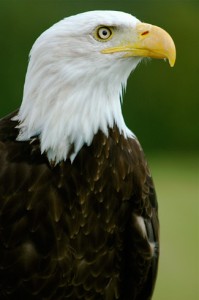
The world over, we have become obsessed with visual representation, an image of something that says who we are. We designate specially designed flags to attest to our individuality as a nation. We assign many other symbols to specifically state – and act as – the identification that expresses our qualities as a nation or body of government.
Throughout the world, many countries have designated a bird as their National Bird. For the United States, the bald eagle has long stood for freedom, long life, and strong might by its splendor of size and ability to be where it wants to be when it wants to be there. Surprisingly, the U.S. has never officially adopted the bald eagle as the National Bird, although it appears on many U.S. documents and its currency.
The history of the bald eagle as a representation of the U.S. dates back to 1782. After the Declaration of Independence was accepted, Congress gave three important people the job of designing an official seal. Benjamin Franklin preferred the turkey. Initially, the white eagle was chosen, but the Secretary of Congress suggested that the more majestic bald eagle be used in the seal. The Roman Empire’s soldiers used the eagle as their symbol of strength, and so this felt appropriate for use in the young United States. Soon enough, the image of the bald eagle was everywhere in the U.S. Currently (in 2024) there is a bill circulating Congress to make the bald eagle official.
National Birds of Other Countries
The U.S. is not the only country with a bird assigned to represent it. Every country in the world, even those no longer in power, have national birds at their core. Strangely – like the U.S. – there are 34 countries that recognize a bird as their symbol but have not adopted them officially to cement their status as such.
Eighty seven countries do have official designations of national birds. Interestingly, most countries with an official national bird are small countries, while large countries like China (red-crowned crane, waiting to be accepted since 2007 after having been proposed), Canada (Canada jay), Australia (emu), and the United Kingdom (European robin) have yet to adopt their oft-used representative bird.
Many smaller countries have national birds, but do not have them as official. These include Germany (golden eagle), France (Gallic rooster), Czech Republic (common kingfisher), Ireland (Northern lapwing), Italy (Italian sparrow), New Zealand (North Island Brown Kiwi), Poland (White Stork), Scotland (Golden Eagle), and Wales (Red Kite). A few Scandinavian countries have a designation but also no official birds. These are: Finland (Whooper Swan), Sweden (Common blackbird), while Norway has adopted the White-throated Dipper, and Denmark officially accepted the Mute Swan in 1984 after a 24-year flirtation with the Eurasian Skylark.
Birds have long represented not only many governments and countries of the world, past and present. But counties, and even cities have gotten to the bird of representation. Yes, our birds are that beautiful. They have displays and qualities that speak to countries and other entities that says, “this is who we are.” You can look at that list further here.
National Parrots


A few countries list parrots as their national bird! All three of these parrots are Amazon parrots, under the genus Amazona. Unfortunately, another thing they have in common is that all three are listed as vulnerable species. Saint Vincent and the Grenadines celebrates the St. Vincent Parrot (Amazona guildingii) as its national bird. This large, multi-colored Amazon is the only type of parrot on the island and is listed as a vulnerable species. According to the Cayman Islands’ Department of Environment (DoE), the Cayman Parrot is the common name for two parrot subspecies found only on Grand Cayman and Cayman Brac. Originally listed as a game bird, the Cayman Parrot was given full protection under the Animals (Protection) Regulations, 1989.

Dominica calls its Sisserou parrot (Amazona imperalis), the Pride of Dominica, This stunning Amazon parrot is also referred to as the Dominican parrot and Imperial Amazon, The parrot figures prominently on the Coat of Arms, the National Flag, The Public Seal, The Mace of the House of Assembly and Dominica’s Honours for Meritorious Service to the Country. It is among the oldest species of Amazon parrot in the world, and is found only in Dominica.
calls its Sisserou parrot (Amazona imperalis), the Pride of Dominica, This stunning Amazon parrot is also referred to as the Dominican parrot and Imperial Amazon, The parrot figures prominently on the Coat of Arms, the National Flag, The Public Seal, The Mace of the House of Assembly and Dominica’s Honours for Meritorious Service to the Country. It is among the oldest species of Amazon parrot in the world, and is found only in Dominica.
